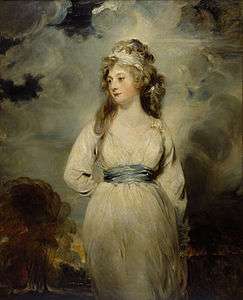Amelia Stewart, Viscountess Castlereagh
Amelia Anne "Emily" Stewart, Marchioness of Londonderry (20 February 1772 – 12 February 1829), from 1794 until 1821 generally known as Lady Castlereagh (UK: /ˈkɑːsəlreɪ/), was the wife of the Georgian-era Irish statesman Robert Stewart, Viscount Castlereagh, who from 1812 to 1822 was British Foreign Secretary and Leader of the House of Commons. Well-connected by birth to the aristocracy and wife of a prominent politician who was Britain's leading diplomat during the close of the Napoleonic Wars, Lady Castlereagh was an influential member of Regency London's high society.

Family
Lady Castlereagh was a daughter of John Hobart, 2nd Earl of Buckinghamshire and his second wife, Caroline Conolly. The Earl of Buckinghamshire was an English courtier and politician who served as British Ambassador to Russia (1762–65) and Lord Lieutenant of Ireland (1776–80).
Her maternal grandfather, William Conolly, was the nephew and heir of William Conolly, Speaker of the Irish House of Commons in the early 18th century and an extremely wealthy Irish landowner. Caroline's brother, Thomas Conolly, a noted Irish sportsman and Lady Castlereagh's uncle, was married to Louisa Lennox, daughter of Charles Lennox, 2nd Duke of Richmond, and one of the famous Lennox sisters. Caroline's mother, Anne Wentworth, was daughter of Thomas Wentworth, 1st Earl of Strafford.
Marriage
Emily Hobart married Robert Stewart, son of the Irish politician and landowner Robert Stewart, 1st Marquess of Londonderry, in 1794. Her husband used his courtesy title, Viscount Castlereagh, from 1796 until 1821, when he succeeded to the marquessate on his father's death.
They were a notably devoted couple but had no children. They did, however, care for the young Frederick Stewart while his father, Charles, Lord Castlereagh's half-brother, was serving in the army.[1] Her devotion to her husband, combined with her love of foreign travel, well equipped Emily for the life of a diplomat's wife, and she was noted for her willingness to accompany her husband abroad, no matter how rigorous the journey.
Husband's suicide
Although there is no doubt that she was concerned by her husband's deteriorating mental condition, which culminated in his suicide in August 1822, she may not have realised quite how serious the matter was. Even days before the suicide she was insisting, in public at least, that while he had been "unwell" he was expected to recover fully. During his last days she was undoubtedly fully aware of his dangerous condition, but was forced to trust in the skill of their doctor, Charles Bankhead. Afterwards she was blamed, perhaps unfairly, by many of his friends and political colleagues for concealing the serious nature of his mental illness: Lord Liverpool, the Prime Minister, in particular accused her of deceiving him about the extent of the problem.[2]
Last years
After her husband's death Emily lived quietly in the country for almost two years. In 1824 she returned to her old social life, arousing the censure of some of her husband's friends who thought her conduct unfeeling.[3] However her health soon failed and she died in 1829.
Social leader
During the Regency of George IV, Lady Castlereagh, along with Lady Jersey, Dorothea Lieven, Lady Cowper, and others, was a Lady Patroness of Almack's, one of the first and most exclusive mixed-gender social clubs in London. In their role as Patroness, they had great influence over the ton, determining social acceptance by designating who might receive "vouchers" (entrance tickets) to Almack's, thereby setting and enforcing complex, unwritten social codes of the London social elite.
Credited with having introduced the quadrille to London, Lady Castlereagh is also remembered for having Almack's doors closed, without exception, at eleven o'clock, even once turning away the Duke of Wellington.[4] Her own parties were considered dull, and her manner was somewhat eccentric: guests described her conversation as an endless flow of trivial information delivered in an oddly detached manner. Despite her frivolous manner, she had been well-educated, and had a passion for literature and music.
At their country home, Woollet Hall, North Cray, Lady Castlereagh kept a private zoo, which featured antelopes, ostriches, kangaroos, and a notably bad-tempered tiger.
Lady Castlereagh is often mentioned in Regency novels, most famously in Georgette Heyer's Regency romances.
References
- "The Cowan Inheritance". Public Records Office of Northern Ireland. 7 September 2006. Archived from the original on 14 November 2007. Retrieved 6 July 2009.
- Hyde, Montgomery The Strange Death of Lord Castlereagh William Heinemann Ltd. London 1959
- Hyde Strange Death of Lord Castlereagh
- Almack's Assembly Rooms, Britain Express. Accessed 18 June 2008.
External links
- Genealogy of Lady Amelia Anne Hobart on The Peerage website
- National Portrait Gallery (London) —Portrait of Amelia Anne (Hobart), Marchioness of Londonderry (Lady Castlereagh), by Richard James Lane, printed by Graf and Soret, lithographic printers, c. 1825–50.